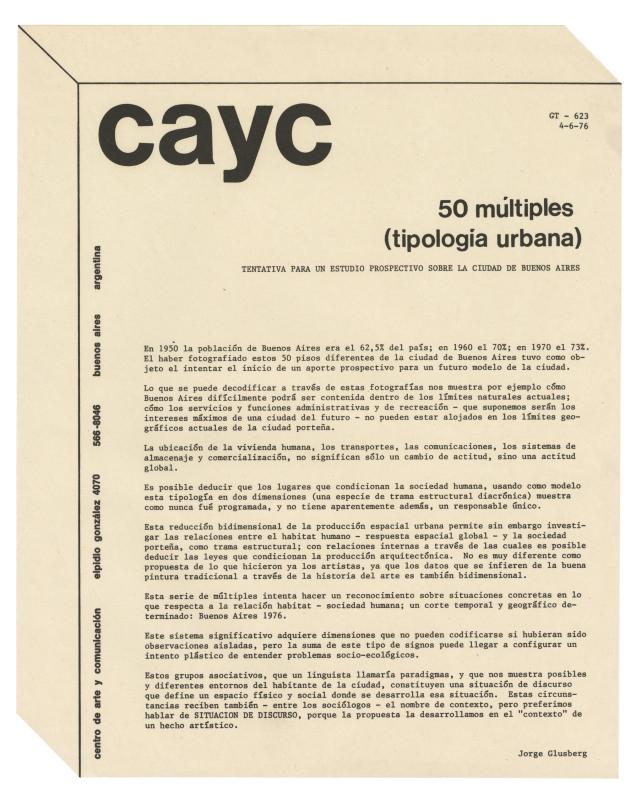Ever since it was founded, the CAYC (Centro de Arte y Comunicación), helmed by the cultural promoter, artist, and businessman Jorge Glusberg, was intended as an interdisciplinary space where an experimental art movement could flourish. The establishment of collaborative networks connecting local and international artists and critics played an important role in this process. The exhibitions shone a light on these exchanges, in which overviews of trends or individual artists provided an introduction to the innovations of international contemporary art and made Argentine and Latin American artists better known on the global scene.
This newsletter includes "El Grupo de los Trece. Bienal de San Pablo," the article written by Glusberg and published immediately after the Buenos Aires based group’s prizewinning presentation at the biennial in Brazil. The large, thematically consistent installation for which Glusberg acted as curator, critic, and artist included individual works whose aesthetic had long identified the CAYC, on this occasion under the title Signos en ecosistemas artificiales.
In the 800 square meters assigned to them on the second floor of the biennial’s pavilion (Parque do Ibirapuera), in the section devoted to Uncatalogued Art, the CAYC members’ works were installed as part of a group presentation. According to Glusberg’s semiotic approach, the distinction between “natural” and “artificial” did not apply in this case because (for man) all objects are signs. The critic sought to express the discursive-space concept in which each work functioned as a supportive component that contributed to the overall narrative.
Tipología urbana was a collection of Glusberg’s own works. It was a new edition of the version presented (for the first time) in 1972 and, subsequently, at Arte en cambio II ¿hay vanguardia en latinoamérica?, which opened at the CAYC in June 1976 (Cf. GT-623 [doc. no. 1477198].) It was an installation of photographs that mused on the “indexical” semiotic nature of photography and the recognition of a city’s identity as expressed in fragmentary views of its street signs, including urban gas distribution valves, municipal logos, and others. Some years later, Glusberg referred to this project in semiotic terms, mentioning its “discursive” nature as regards a synchronic whole (the city’s road surfaces at any given time) and a diachronic whole (different periods evoked by different types of paving and their degree of wear). He describes the work as an expression of a measure of “diversity” within that whole (markedly different surfaces in the same area) and in terms of a “prospective” quality: surfaces seen as what sustain and aspire to future construction. (Glusberg, J., Del pop art a la nueva imagen [Buenos Aires: Gaglianone, 1985], 221–25.)
For the first time, the Brazilian Ministry of Foreign Relations’ Grande Prêmio Itamaraty was awarded to a representative of Latin America. The presentation at the São Paulo Biennial recognized both the CAYC and the group for their submission and granted the CAYC a level of international prestige that far exceeded all the acknowledgements it had received up to that point in time. In the months prior to the group’s joint participation in the XIV São Paulo Biennial, the CAYC organized solo exhibitions for some of the members of the Grupo de los Trece and promoted their works in its newsletters. (See 737 [doc. no. 1477389], GT-738 [doc. no. 1477390], GT-746 [doc. no. 1477396], GT-757 [doc. no. 1477397], GT-758 [doc. no. 1477398], GT-759 [doc. no. 1477399], GT-761 [doc. no. 1477419], GT-765 [doc. no. 1477432], GT-766 [doc. no. 1477433], GT-772 [doc. no. 1477435], GT-773 [doc. no. 1477436], GT-774-775 [doc. no. 1477437], GT-787 and GT-788 [doc. no. 1477450], GT-789 and 790 [doc. no. 1477452], GT-791-793 [doc. no. 1477454], GT-794-796 [doc. no. 1477457], GT-797-798 [doc. no. 1477460], GT-799 [doc. no. 1477462], and GT-800-801 [doc. no. 1477463].)














